
8 minute read
A new smile for Andrea
Digitally manufactured interim rehabilitation of a challenging case By Eric D. Kukucka, DD, Windsor/Canada
Experience this clinical case online!
Advertisement
In the complex case of Andrea, a team of prosthetic experts demonstrated how a new denture can literally change the life of a patient. An interim denture was fabricated for the young patient using the Digital Denture process. This solution immensely improved the patient’s well-being and quality of life.
The following article describes the interdisciplinary treatment approach taken to treat a young patient who suffered considerably from physical and psychological issues which stemmed from her dental condition (Fig. 1). In order to solve such a case, the smooth collaboration of the dental practice and the dental laboratory is indispensible, in addition to excellent dental and dental laboratory expertise and coordinated manufacturing techniques. In the present case, the solution started with an interim denture, which allowed the patient to regain her “normal” jaw function and esthetic appearance.
Patient history
When Andrea consulted us for the first time at 25 years of age she had already suffered from various symptoms for several years. Her complaints were caused by two different disorders, which led to serious consequences, individually and in combination. The young woman suffered from a genetic disorder, one of the symptoms of which presents as very weak tooth enamel. Furthermore, the patient was afflicted with fibromyalgia, a chronic pain disorder accompanied by immense psychological stress. As a consequence, the patient had been vomiting three to four times a day on average over a period of several years. The resultant acid erosion significantly damaged her already severely compromised dentition (Fig. 2).
Effects of the illness
The patient reported that she was experiencing unbearable pain and that she had
01a 01b 01 — Initial situation: young patient suffering physically and emotionally

01c
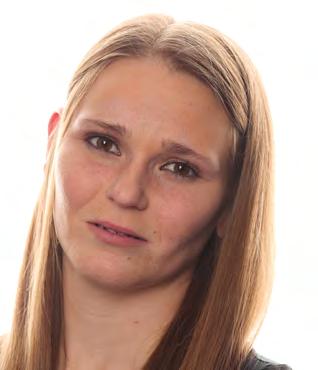

03

02 02 — Severely damaged remaining teeth
03 — Virtual extraction of the existing teeth in the software
04 — Virtual model analysis
05 — Opening of the vertical dimension by 5.5 mm and selection of the tooth moulds in the Digital Denture Full Arch tooth library
04

05a
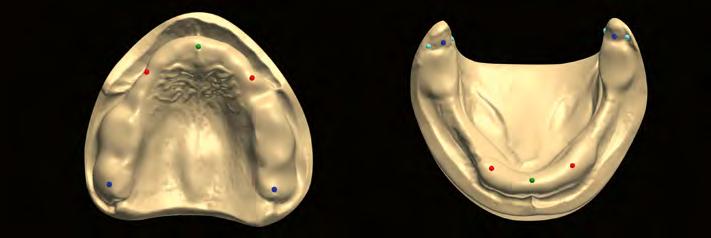
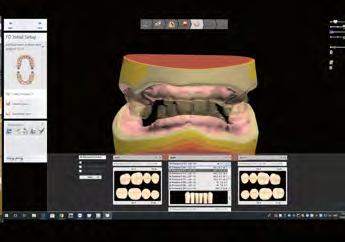
05b
suffered numerous oral infections. Over the years, Andrea had to take “countless” courses of antibiotics, the effectiveness of which diminished over time. As a result of these infections, several teeth had to be extracted. Andrea’s grave oral health situation interfered with her ability to eat.
The unattractive appearance of her teeth profoundly affected her emotionally. Her mental health and her self-concept suffered as a result. She described her previous dentist visits as “horrendous” experiences. Therefore, she was initially reluctant to agree to the suggested complex treatment. However, we were able to convince her of the necessity of the procedure in the course of very caring and empathetic conversations.
Treatment goals
After many discussions, an initial treatment goal was defined: The teeth that could not be saved would be extracted and an interim denture would be fabricated as a temporary solution. In a treatment second phase, implants would be placed. As a first priority, however, we focused on improving the patient’s quality of life. We chose to use the Digital Denture process in order to offer the patient a “comfortable” treatment modality and ensure predictable results for the dental team. Since the patient did not wish to be toothless at any stage of the treatment, an interim denture had to be available at the tooth extraction appointment.
Treatment process
First of all, impressions of the upper and lower jaws were taken and the models were cast. Subsequently, the models were digitized with a laboratory scanner (3Shape). The data records were transferred to the Digital Denture software program, which allowed us to fabricate a set of tooth-coloured dentures with SR IvoBase ® CAD and SR Vivodent ® CAD Multi using an automatic manufacturing process.
CAD construction of the interim denture
Before the interim denture could be designed, the remaining teeth had to be removed from the virtual model (Fig. 3). For this purpose, the software program features a virtual extraction tool. The software guided us through the model analysis process, one step at a time. We marked the anatomical characteristics and established the significant parameters for the denture (Fig. 4). Based on the maxillomandibular relationship record, the vertical dimension was opened by 5.5 mm (Fig. 5a). Suitable tooth moulds were selected from the Digital Denture Full Arch tooth library (Phonares ® II B71-L50-N3) (Fig.5b).
06 — The software automatically generates a set-up suggestion 06
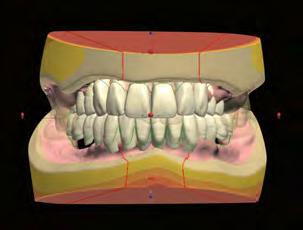
07 — The SR Vivodent CAD Multi disc is mounted with the labelling facing upwards 07


08 — The IvoBase CAD disc is mounted for the fabrication of the denture base 08
09 — Roughly milled tooth arches and denture bases after the first milling cycle 09a 09b


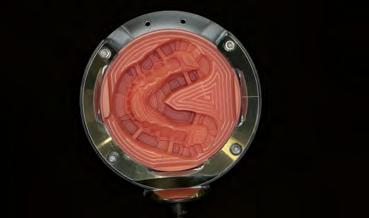
09c
10 — Upper interim denture after attaching the tooth arch to the denture base. The translucent properties of the incisal area are striking. 10a 10b
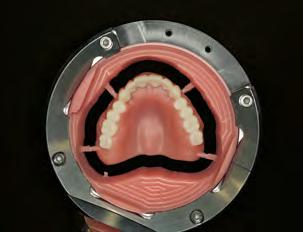


11 — The interim denture after the precision milling process 11
The software automatically generated a suggestion for setting up the selected teeth (Fig. 6). If desired, this set-up can be customized. Next, we checked the basic parameters (tooth length, midline, bite, etc.) and made the necessary fine adjustments in the software. In addition, we finalized the denture base and characterized the gingival contours. The software offers various tools for adding, removing or smoothing dental material.
CAM manufacturing of the interim denture
The CAD file was saved and the software generated a CAM output file for milling the dental arch and the denture base. The dental arch was milled from a biocompatible, highly cross-linked polychromatic PMMA-based DCL material (SR Vivodent CAD Multi) (Fig. 7). It is characterized by its special Pearl Structure Effect, which ensures an even progression of the shade. We selected shade A1. The multi-chromatic colour gradient of the disc – incisal, dentin, cervical area – imparts the milled monolithic teeth with a very natural looking appearance with very little reworking. The Digital Denture system incorporates a number of different gingiva coloured PMMA discs (IvoBase CAD). The shades of these discs are matched to those of the IvoBase denture base materials (preference Pink, Pink V, 34V) (Fig. 8).
The oversize process
In a first step, the CAM machine (PrograMill PM7) coarsely milled the dental arch. The dental arch was produced in oversized form and the base surfaces were exactly milled to fit the denture base (Fig.9). In the next step, the tooth arch and the denture base were bonded together. An efficient, easy-to-use, self-curing two-component bonding agent was used (IvoBase CAD Bond) for this purpose (Fig. 9). The tooth arch and the denture base were finalized in the subsequent precision milling and finishing process (Figs 10 and 11).
Completion of the interim dentures

12 — The patient one week after the extraction of all her teeth and the immediate placement of the interim denture
13 — Impressive collage of before-and-after portraits of the patient. In a follow-up interview, the patient commented on the substantial improvement in the quality of life that the dentures had given her.
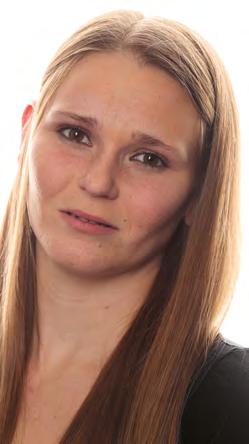
13b


13c 13d

concave and convex areas – of the denture base had been saved to the software and then machined in a 1:1 ratio. At this stage, the microtexture of the teeth and the gingiva can be customized. Fine wear facets can be added if desired in order to enhance the lifelike appearance of the denture. In the present case, the denture was pre-polished with a dental handpiece and then polished to a final high gloss in a polishing unit, using pumice and a universal polishing paste and a cotton buffing wheel.
Tooth extraction and the new smile
The teeth were extracted under full anaesthetic and slight alveoloplasty was conducted. As a result, ideal conditions were created for the denture. The patient left the practice after the surgical intervention wearing the new interim denture. One week later she presented to the practice for a recall appointment. By that time not only her appearance, but also her demeanour had changed remarkably. She radiated vitality and self-confidence (Fig. 12).
Conclusion
The primary treatment phase represented an important part of the overall rehabilitation. The patient obtained a beautiful smile and a measurably improved quality of life (Fig. 13). Due to the Digital Denture system, the treatment required relatively little time and effort. Today, the young woman is broadly happy, self-assured and motivated to take the next treatment step.
Eric D. Kukucka, DD The Denture Center 2601 Lauzon Parkway #750, Windsor, ON N8T 3M4 Canada erickukucka@gmail.com View article online





